FIAT QUBO 2017 1.G Owners Manual
Manufacturer: FIAT, Model Year: 2017, Model line: QUBO, Model: FIAT QUBO 2017 1.GPages: 260, PDF Size: 4.74 MB
Page 131 of 260
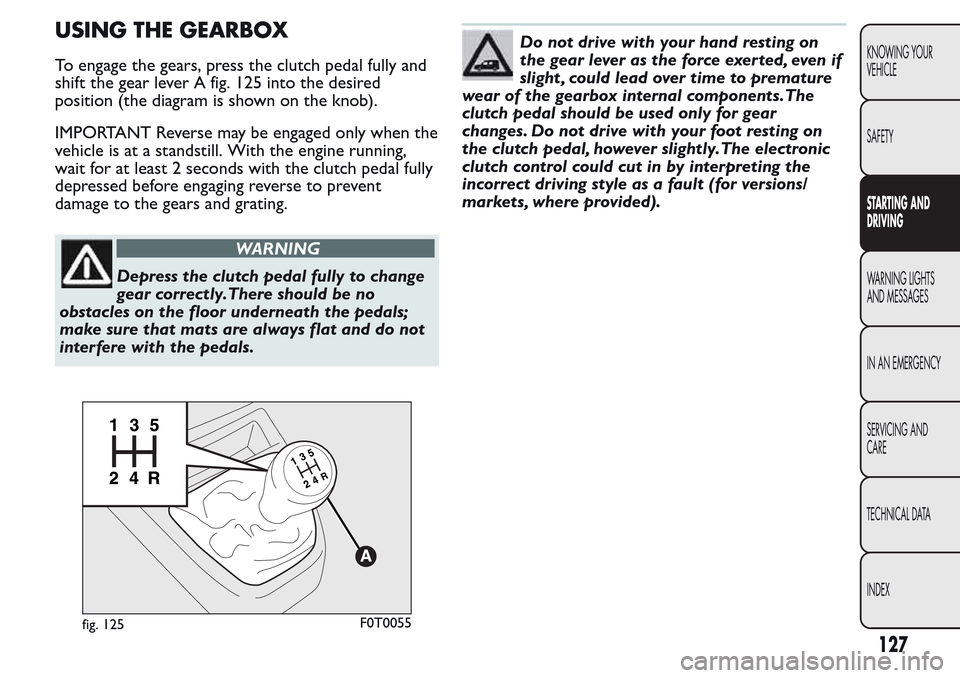
USING THE GEARBOX
To engage the gears, press the clutch pedal fully and
shift the gear lever A fig. 125 into the desired
position (the diagram is shown on the knob).
IMPORTANT Reverse may be engaged only when the
vehicle is at a standstill. With the engine running,
wait for at least 2 seconds with the clutch pedal fully
depressed before engaging reverse to prevent
damage to the gears and grating.
WARNING
Depress the clutch pedal fully to change
gear correctly.There should be no
obstacles on the floor underneath the pedals;
make sure that mats are always flat and do not
interfere with the pedals.
Do not drive with your hand resting on
the gear lever as the force exerted, even if
slight , could lead over time to premature
wear of the gearbox internal components.The
clutch pedal should be used only for gear
changes. Do not drive with your foot resting on
the clutch pedal, however slightly.The electronic
clutch control could cut in by interpreting the
incorrect driving style as a fault (for versions/
markets, where provided).
fig. 125F0T0055
127
KNOWING YOUR
VEHICLE
SAFETY
STARTING AND
DRIVING
WARNING LIGHTS
AND MESSAGES
IN AN EMERGENCY
SERVICING AND
CARE
TECHNICAL DATA
INDEX
Page 132 of 260
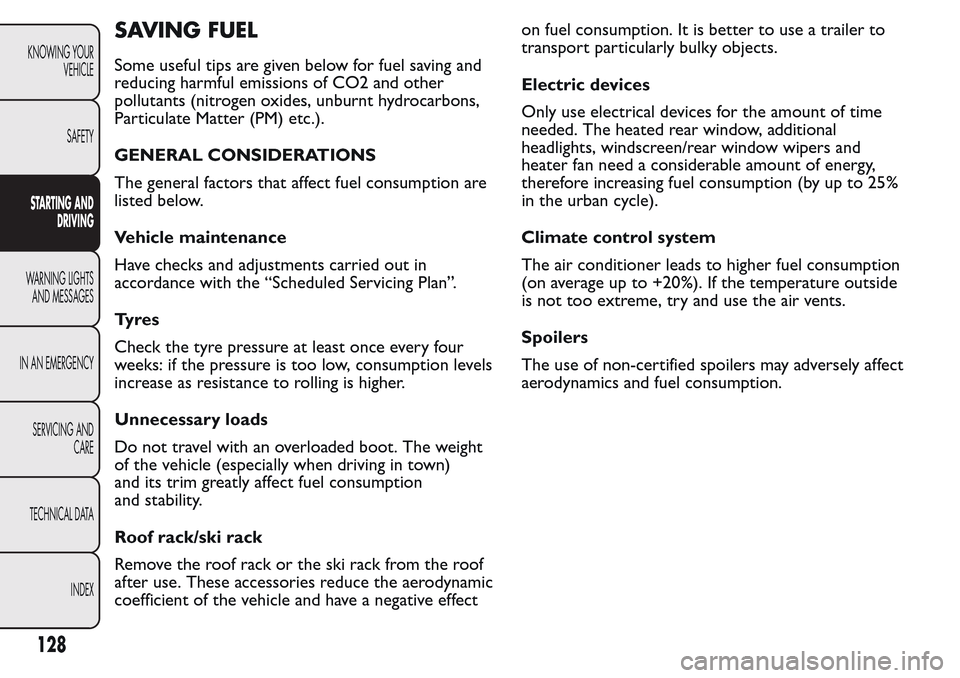
SAVING FUEL
Some useful tips are given below for fuel saving and
reducing harmful emissions of CO2 and other
pollutants (nitrogen oxides, unburnt hydrocarbons,
Particulate Matter (PM) etc.).
GENERAL CONSIDERATIONS
The general factors that affect fuel consumption are
listed below.
Vehicle maintenance
Have checks and adjustments carried out in
accordance with the “Scheduled Servicing Plan”.
Ty r e s
Check the tyre pressure at least once every four
weeks: if the pressure is too low, consumption levels
increase as resistance to rolling is higher.
Unnecessary loads
Do not travel with an overloaded boot. The weight
of the vehicle (especially when driving in town)
and its trim greatly affect fuel consumption
and stability.
Roof rack/ski rack
Remove the roof rack or the ski rack from the roof
after use. These accessories reduce the aerodynamic
coefficient of the vehicle and have a negative effecton fuel consumption. It is better to use a trailer to
transport particularly bulky objects.
Electric devices
Only use electrical devices for the amount of time
needed. The heated rear window, additional
headlights, windscreen/rear window wipers and
heater fan need a considerable amount of energy,
therefore increasing fuel consumption (by up to 25%
in the urban cycle).
Climate control system
The air conditioner leads to higher fuel consumption
(on average up to +20%). If the temperature outside
is not too extreme, try and use the air vents.
Spoilers
The use of non-certified spoilers may adversely affect
aerodynamics and fuel consumption.
128
KNOWING YOUR
VEHICLE
SAFETY
STARTING AND
DRIVING
WARNING LIGHTS
AND MESSAGES
IN AN EMERGENCY
SERVICING AND
CARE
TECHNICAL DATA
INDEX
Page 133 of 260
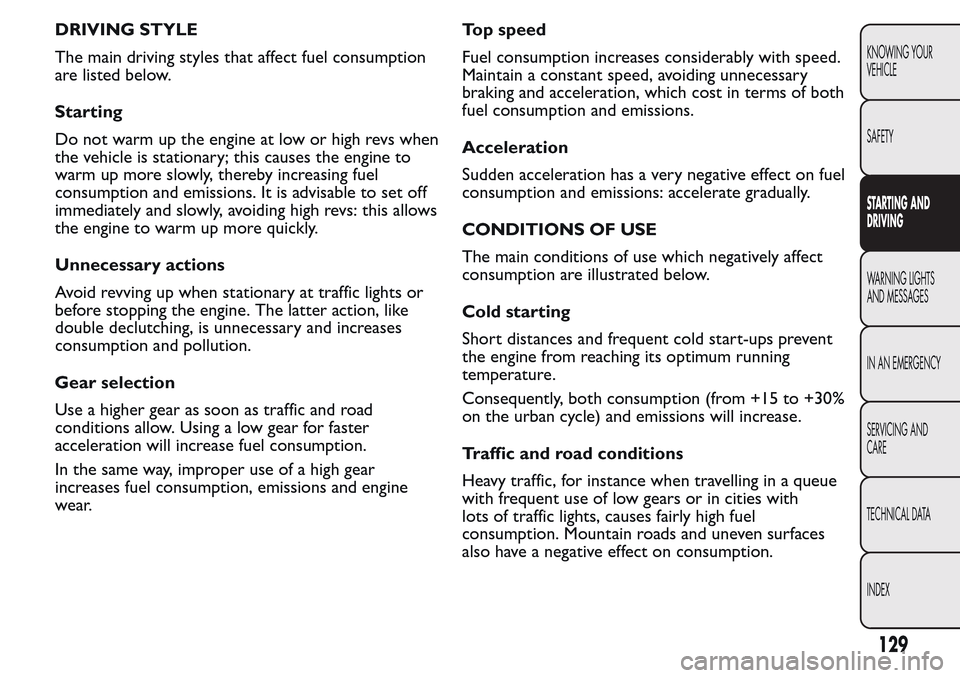
DRIVING STYLE
The main driving styles that affect fuel consumption
are listed below.
Starting
Do not warm up the engine at low or high revs when
the vehicle is stationary; this causes the engine to
warm up more slowly, thereby increasing fuel
consumption and emissions. It is advisable to set off
immediately and slowly, avoiding high revs: this allows
the engine to warm up more quickly.
Unnecessary actions
Avoid revving up when stationary at traffic lights or
before stopping the engine. The latter action, like
double declutching, is unnecessary and increases
consumption and pollution.
Gear selection
Use a higher gear as soon as traffic and road
conditions allow. Using a low gear for faster
acceleration will increase fuel consumption.
In the same way, improper use of a high gear
increases fuel consumption, emissions and engine
wear.Top speed
Fuel consumption increases considerably with speed.
Maintain a constant speed, avoiding unnecessary
braking and acceleration, which cost in terms of both
fuel consumption and emissions.
Acceleration
Sudden acceleration has a very negative effect on fuel
consumption and emissions: accelerate gradually.
CONDITIONS OF USE
The main conditions of use which negatively affect
consumption are illustrated below.
Cold starting
Short distances and frequent cold start-ups prevent
the engine from reaching its optimum running
temperature.
Consequently, both consumption (from +15 to +30%
on the urban cycle) and emissions will increase.
Traffic and road conditions
Heavy traffic, for instance when travelling in a queue
with frequent use of low gears or in cities with
lots of traffic lights, causes fairly high fuel
consumption. Mountain roads and uneven surfaces
also have a negative effect on consumption.
129
KNOWING YOUR
VEHICLE
SAFETY
STARTING AND
DRIVING
WARNING LIGHTS
AND MESSAGES
IN AN EMERGENCY
SERVICING AND
CARE
TECHNICAL DATA
INDEX
Page 134 of 260
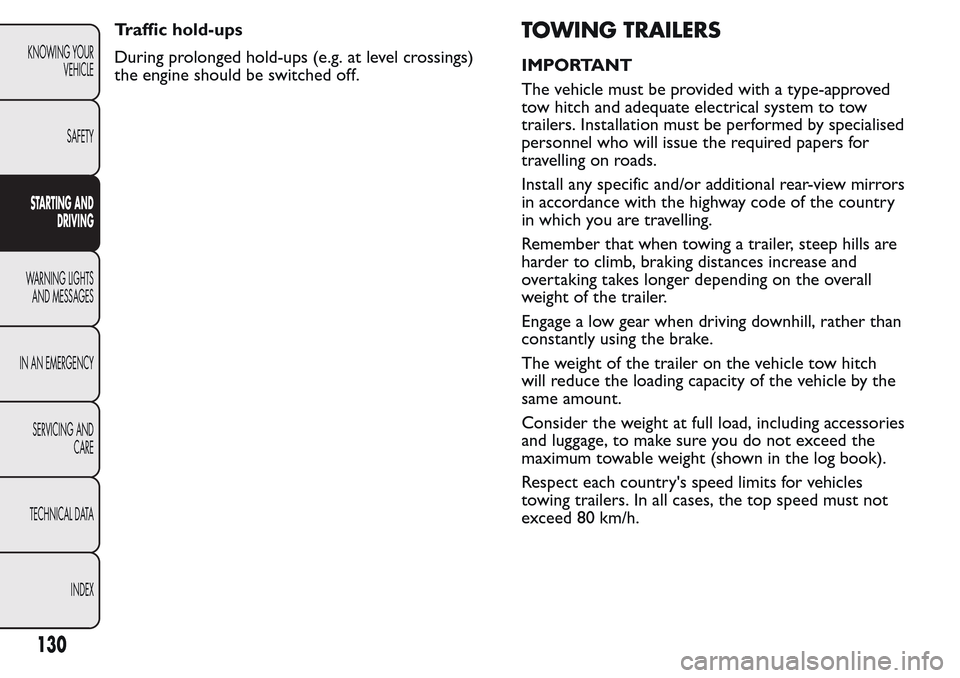
Traffic hold-ups
During prolonged hold-ups (e.g. at level crossings)
the engine should be switched off.TOWING TRAILERS
IMPORTANT
The vehicle must be provided with a type-approved
tow hitch and adequate electrical system to tow
trailers. Installation must be performed by specialised
personnel who will issue the required papers for
travelling on roads.
Install any specific and/or additional rear-view mirrors
in accordance with the highway code of the country
in which you are travelling.
Remember that when towing a trailer, steep hills are
harder to climb, braking distances increase and
overtaking takes longer depending on the overall
weight of the trailer.
Engage a low gear when driving downhill, rather than
constantly using the brake.
The weight of the trailer on the vehicle tow hitch
will reduce the loading capacity of the vehicle by the
same amount.
Consider the weight at full load, including accessories
and luggage, to make sure you do not exceed the
maximum towable weight (shown in the log book).
Respect each country's speed limits for vehicles
towing trailers. In all cases, the top speed must not
exceed 80 km/h.
130
KNOWING YOUR
VEHICLE
SAFETY
STARTING AND
DRIVING
WARNING LIGHTS
AND MESSAGES
IN AN EMERGENCY
SERVICING AND
CARE
TECHNICAL DATA
INDEX
Page 135 of 260
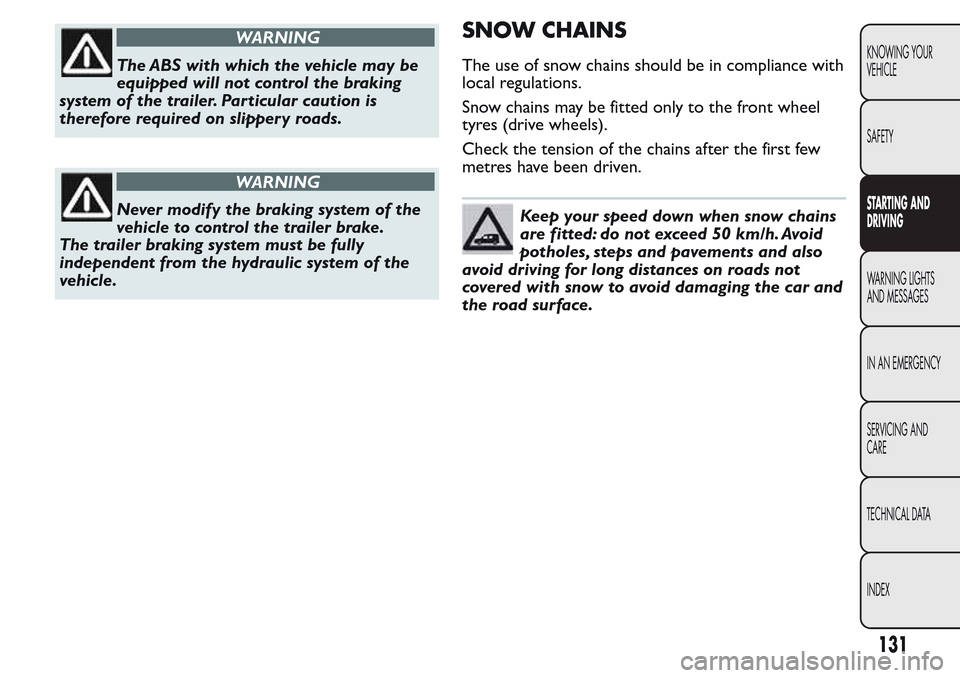
WARNING
The ABS with which the vehicle may be
equipped will not control the braking
system of the trailer. Particular caution is
therefore required on slippery roads.
WARNING
Never modify the braking system of the
vehicle to control the trailer brake.
The trailer braking system must be fully
independent from the hydraulic system of the
vehicle.
SNOW CHAINS
The use of snow chains should be in compliance with
local regulations.
Snow chains may be fitted only to the front wheel
tyres (drive wheels).
Check the tension of the chains after the first few
metres have been driven.
Keep your speed down when snow chains
are fitted: do not exceed 50 km/h. Avoid
potholes, steps and pavements and also
avoid driving for long distances on roads not
covered with snow to avoid damaging the car and
the road surface.
131
KNOWING YOUR
VEHICLE
SAFETY
STARTING AND
DRIVING
WARNING LIGHTS
AND MESSAGES
IN AN EMERGENCY
SERVICING AND
CARE
TECHNICAL DATA
INDEX
Page 136 of 260
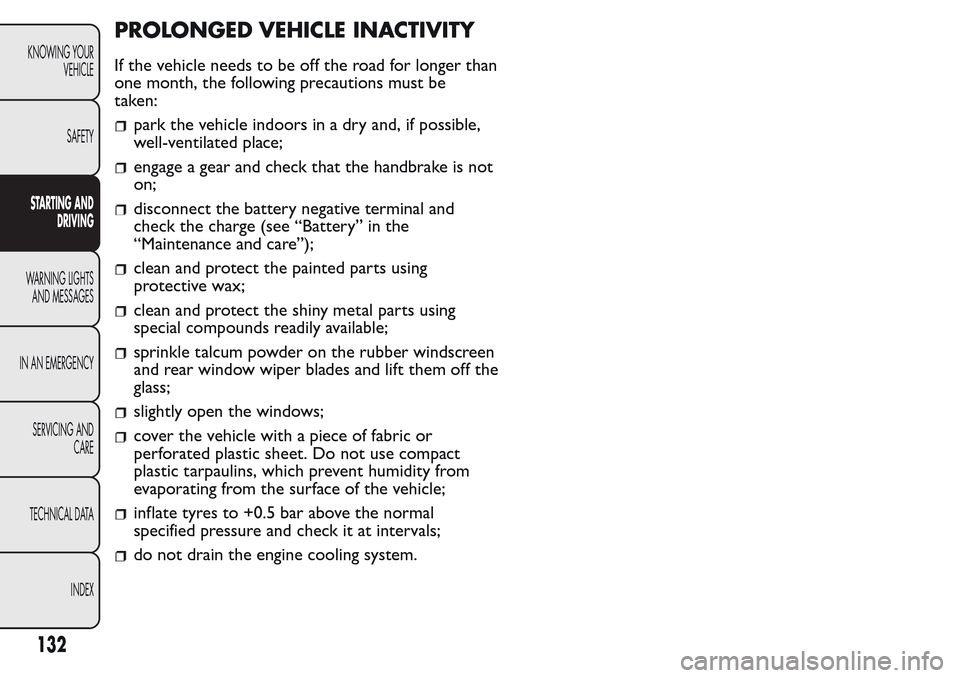
PROLONGED VEHICLE INACTIVITY
If the vehicle needs to be off the road for longer than
one month, the following precautions must be
taken:
park the vehicle indoors in a dry and, if possible,
well-ventilated place;
engage a gear and check that the handbrake is not
on;
disconnect the battery negative terminal and
check the charge (see “Battery” in the
“Maintenance and care”);
clean and protect the painted parts using
protective wax;
clean and protect the shiny metal parts using
special compounds readily available;
sprinkle talcum powder on the rubber windscreen
and rear window wiper blades and lift them off the
glass;
slightly open the windows;
cover the vehicle with a piece of fabric or
perforated plastic sheet. Do not use compact
plastic tarpaulins, which prevent humidity from
evaporating from the surface of the vehicle;
inflate tyres to +0.5 bar above the normal
specified pressure and check it at intervals;
do not drain the engine cooling system.
132
KNOWING YOUR
VEHICLE
SAFETY
STARTING AND
DRIVING
WARNING LIGHTS
AND MESSAGES
IN AN EMERGENCY
SERVICING AND
CARE
TECHNICAL DATA
INDEX
Page 137 of 260
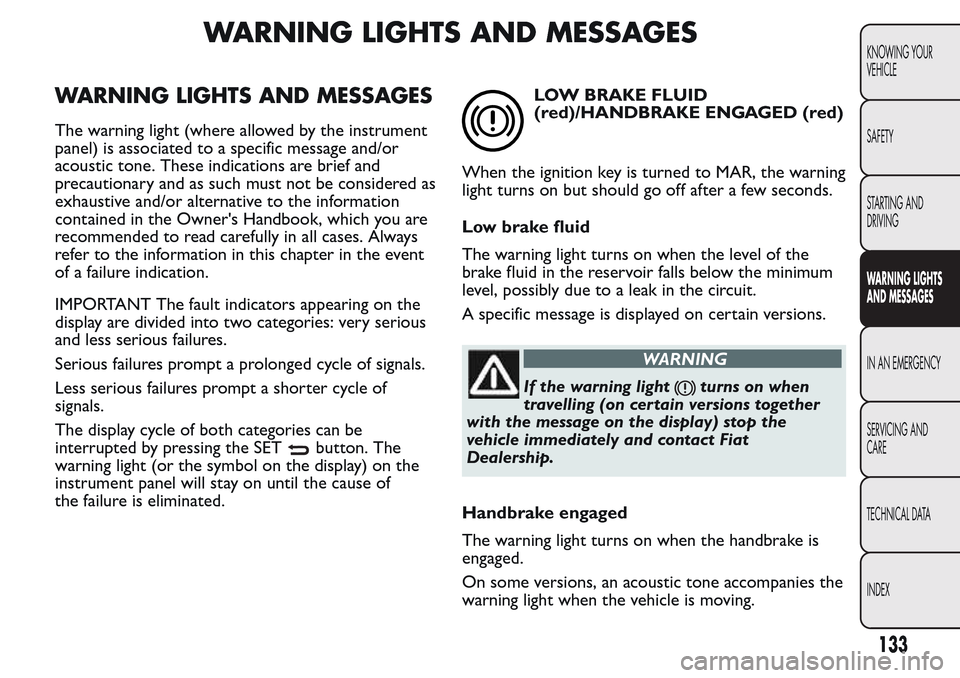
WARNING LIGHTS AND MESSAGES
WARNING LIGHTS AND MESSAGES
The warning light (where allowed by the instrument
panel) is associated to a specific message and/or
acoustic tone. These indications are brief and
precautionary and as such must not be considered as
exhaustive and/or alternative to the information
contained in the Owner's Handbook, which you are
recommended to read carefully in all cases. Always
refer to the information in this chapter in the event
of a failure indication.
IMPORTANT The fault indicators appearing on the
display are divided into two categories: very serious
and less serious failures.
Serious failures prompt a prolonged cycle of signals.
Less serious failures prompt a shorter cycle of
signals.
The display cycle of both categories can be
interrupted by pressing the SET
button. The
warning light (or the symbol on the display) on the
instrument panel will stay on until the cause of
the failure is eliminated.
LOW BRAKE FLUID
(red)/HANDBRAKE ENGAGED (red)
When the ignition key is turned to MAR, the warning
light turns on but should go off after a few seconds.
Low brake fluid
The warning light turns on when the level of the
brake fluid in the reservoir falls below the minimum
level, possibly due to a leak in the circuit.
A specific message is displayed on certain versions.
WARNING
If the warning lightturns on when
travelling (on cer tain versions together
with the message on the display) stop the
vehicle immediately and contact Fiat
Dealership.
Handbrake engaged
The warning light turns on when the handbrake is
engaged.
On some versions, an acoustic tone accompanies the
warning light when the vehicle is moving.
133
KNOWING YOUR
VEHICLE
SAFETY
STARTING AND
DRIVING
WARNING LIGHTS
AND MESSAGES
IN AN EMERGENCY
SERVICING AND
CARE
TECHNICAL DATA
INDEX
Page 138 of 260
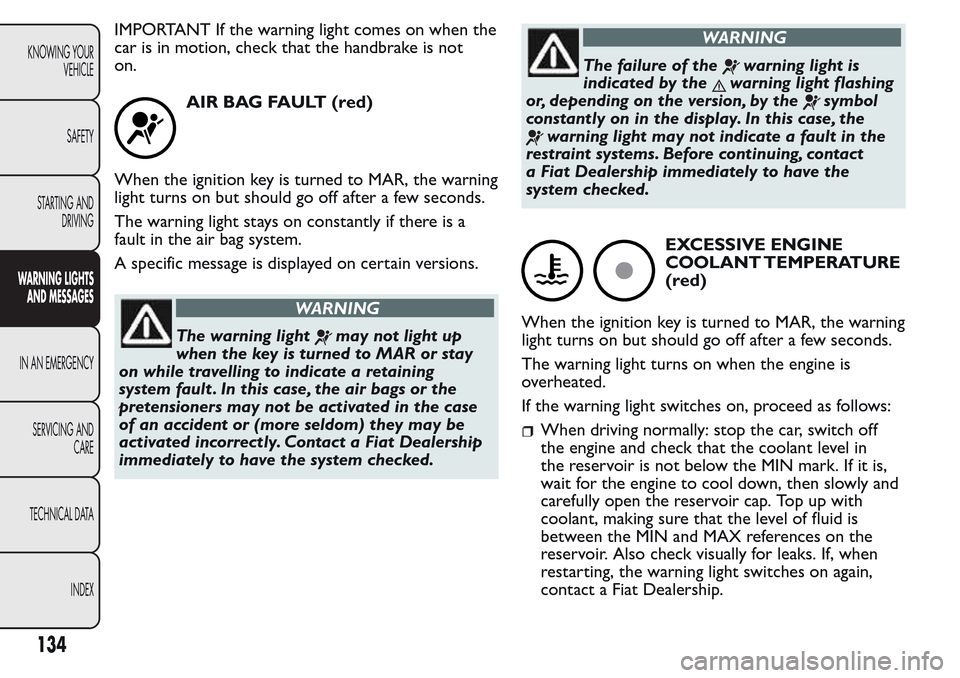
IMPORTANT If the warning light comes on when the
car is in motion, check that the handbrake is not
on.
AIR BAG FAULT (red)
When the ignition key is turned to MAR, the warning
light turns on but should go off after a few seconds.
The warning light stays on constantly if there is a
fault in the air bag system.
A specific message is displayed on certain versions.
WARNING
The warning lightmay not light up
when the key is turned to MAR or stay
on while travelling to indicate a retaining
system fault . In this case, the air bags or the
pretensioners may not be activated in the case
of an accident or (more seldom) they may be
activated incorrectly. Contact a Fiat Dealership
immediately to have the system checked.
WARNING
The failure of thewarning light is
indicated by the
warning light flashing
or, depending on the version, by the
symbol
constantly on in the display. In this case, the
warning light may not indicate a fault in the
restraint systems. Before continuing, contact
a Fiat Dealership immediately to have the
system checked.
EXCESSIVE ENGINE
COOLANT TEMPERATURE
(red)
When the ignition key is turned to MAR, the warning
light turns on but should go off after a few seconds.
The warning light turns on when the engine is
overheated.
If the warning light switches on, proceed as follows:
When driving normally: stop the car, switch off
the engine and check that the coolant level in
the reservoir is not below the MIN mark. If it is,
wait for the engine to cool down, then slowly and
carefully open the reservoir cap. Top up with
coolant, making sure that the level of fluid is
between the MIN and MAX references on the
reservoir. Also check visually for leaks. If, when
restarting, the warning light switches on again,
contact a Fiat Dealership.
134
KNOWING YOUR
VEHICLE
SAFETY
STARTING AND
DRIVING
WARNING LIGHTS
AND MESSAGES
IN AN EMERGENCY
SERVICING AND
CARE
TECHNICAL DATA
INDEX
Page 139 of 260
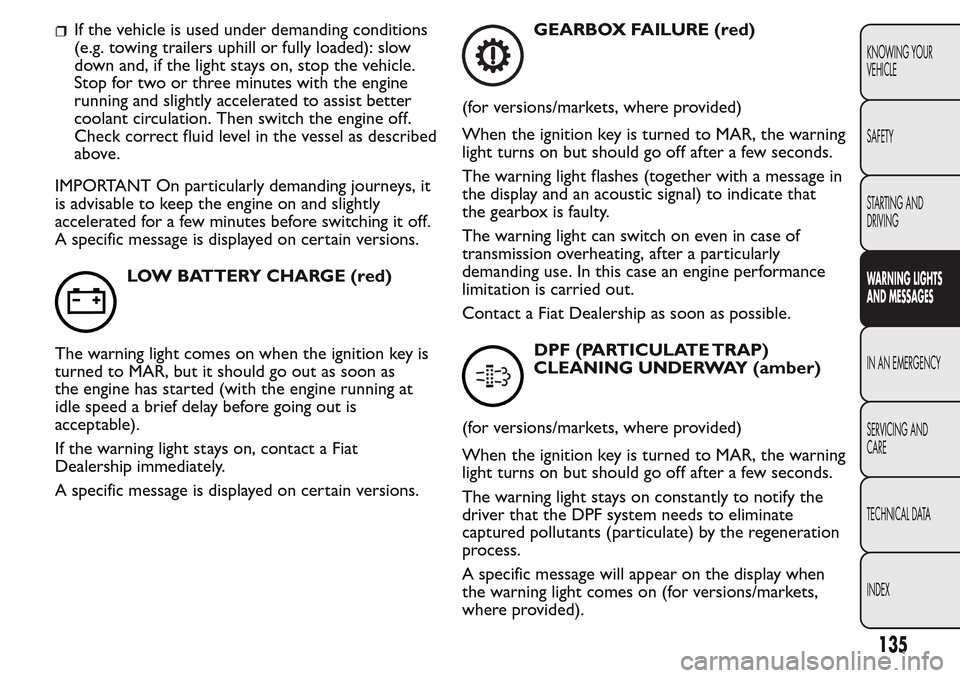
If the vehicle is used under demanding conditions
(e.g. towing trailers uphill or fully loaded): slow
down and, if the light stays on, stop the vehicle.
Stop for two or three minutes with the engine
running and slightly accelerated to assist better
coolant circulation. Then switch the engine off.
Check correct fluid level in the vessel as described
above.
IMPORTANT On particularly demanding journeys, it
is advisable to keep the engine on and slightly
accelerated for a few minutes before switching it off.
A specific message is displayed on certain versions.
LOW BATTERY CHARGE (red)
The warning light comes on when the ignition key is
turned to MAR, but it should go out as soon as
the engine has started (with the engine running at
idle speed a brief delay before going out is
acceptable).
If the warning light stays on, contact a Fiat
Dealership immediately.
A specific message is displayed on certain versions.
GEARBOX FAILURE (red)
(for versions/markets, where provided)
When the ignition key is turned to MAR, the warning
light turns on but should go off after a few seconds.
The warning light flashes (together with a message in
the display and an acoustic signal) to indicate that
the gearbox is faulty.
The warning light can switch on even in case of
transmission overheating, after a particularly
demanding use. In this case an engine performance
limitation is carried out.
Contact a Fiat Dealership as soon as possible.
DPF (PARTICULATE TRAP)
CLEANING UNDERWAY (amber)
(for versions/markets, where provided)
When the ignition key is turned to MAR, the warning
light turns on but should go off after a few seconds.
The warning light stays on constantly to notify the
driver that the DPF system needs to eliminate
captured pollutants (particulate) by the regeneration
process.
A specific message will appear on the display when
the warning light comes on (for versions/markets,
where provided).
135
KNOWING YOUR
VEHICLE
SAFETY
STARTING AND
DRIVING
WARNING LIGHTS
AND MESSAGES
IN AN EMERGENCY
SERVICING AND
CARE
TECHNICAL DATA
INDEX
Page 140 of 260
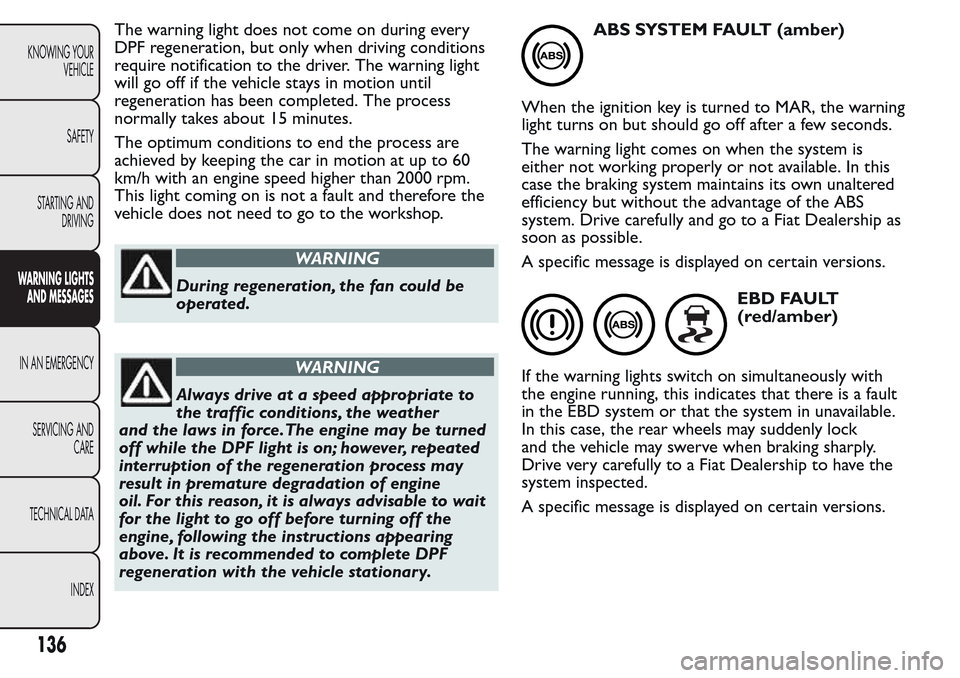
The warning light does not come on during every
DPF regeneration, but only when driving conditions
require notification to the driver. The warning light
will go off if the vehicle stays in motion until
regeneration has been completed. The process
normally takes about 15 minutes.
The optimum conditions to end the process are
achieved by keeping the car in motion at up to 60
km/h with an engine speed higher than 2000 rpm.
This light coming on is not a fault and therefore the
vehicle does not need to go to the workshop.
WARNING
During regeneration, the fan could be
operated.
WARNING
Always drive at a speed appropriate to
the traffic conditions, the weather
and the laws in force.The engine may be turned
off while the DPF light is on; however, repeated
interruption of the regeneration process may
result in premature degradation of engine
oil. For this reason, it is always advisable to wait
for the light to go off before turning off the
engine, following the instructions appearing
above. It is recommended to complete DPF
regeneration with the vehicle stationar y.
ABS SYSTEM FAULT (amber)
When the ignition key is turned to MAR, the warning
light turns on but should go off after a few seconds.
The warning light comes on when the system is
either not working properly or not available. In this
case the braking system maintains its own unaltered
efficiency but without the advantage of the ABS
system. Drive carefully and go to a Fiat Dealership as
soon as possible.
A specific message is displayed on certain versions.
EBD FAULT
(red/amber)
If the warning lights switch on simultaneously with
the engine running, this indicates that there is a fault
in the EBD system or that the system in unavailable.
In this case, the rear wheels may suddenly lock
and the vehicle may swerve when braking sharply.
Drive very carefully to a Fiat Dealership to have the
system inspected.
A specific message is displayed on certain versions.
136
KNOWING YOUR
VEHICLE
SAFETY
STARTING AND
DRIVING
WARNING LIGHTS
AND MESSAGES
IN AN EMERGENCY
SERVICING AND
CARE
TECHNICAL DATA
INDEX